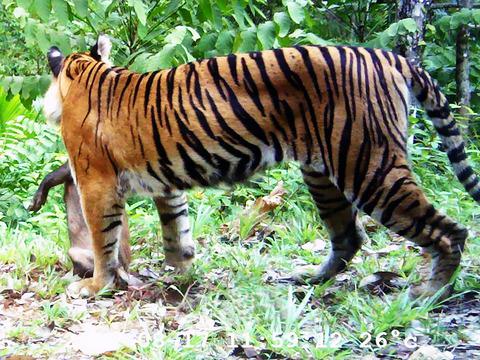当前位置:
X-MOL 学术
›
Anim. Conserv.
›
论文详情
Our official English website, www.x-mol.net, welcomes your feedback! (Note: you will need to create a separate account there.)
Unraveling the complexity of human–tiger conflicts in the Leuser Ecosystem, Sumatra
Animal Conservation ( IF 3.4 ) Pub Date : 2020-05-08 , DOI: 10.1111/acv.12591 M. I. Lubis 1, 2 , W. Pusparini 1, 3 , S. A. Prabowo 4 , W. Marthy 1 , Tarmizi 1 , N. Andayani 1 , M. Linkie 1
Animal Conservation ( IF 3.4 ) Pub Date : 2020-05-08 , DOI: 10.1111/acv.12591 M. I. Lubis 1, 2 , W. Pusparini 1, 3 , S. A. Prabowo 4 , W. Marthy 1 , Tarmizi 1 , N. Andayani 1 , M. Linkie 1
Affiliation

|
Conserving large carnivores that live in close proximity to people depends on a variety of socio‐economic, political and biological factors. These include local tolerance toward potentially dangerous animals, efficacy of human–carnivore conflict mitigation schemes, and identifying and then addressing the underlying causes of conflict. The Leuser Ecosystem is the largest contiguous forest habitat for the critically endangered Sumatran tiger. Its extensive forest edge is abutted by farming communities and we predict that spatial variation in human–tiger conflict (HTC) would be a function of habitat conversion, livestock abundance, and poaching of tiger and its wild prey. To investigate which of these potential drivers of conflict, as well as other biophysical factors, best explain the observed patterns, we used resource selection function (RSF) technique to develop a predictive spatially explicit model of HTC. From 148 conflict incidences recorded from 2008 to 2018 across the Leuser Ecosystem, the areas that were closer to villages and with lower occurrence of wild prey were most susceptible to tiger attacks. From 18 districts monitored, 6 stood out for having disproportionately high levels of HTC. We recommend that these areas be prioritized with increased support from conflict mitigation teams to prevent further injuries to people, livestock or tigers; district governments address one underlying cause of HTC by supporting improved animal husbandry practices, such as tiger‐proof livestock pen construction; and, an increase in ranger patrol effort to recover wild prey populations. This type of priority setting approach has wide application for better determining the required management response to reduce conflicts between people and large carnivores in both tropical and temporal landscapes.
中文翻译:

苏门答腊Leuser生态系统中人与老虎冲突的复杂性
保护生活在人们附近的大型食肉动物,取决于各种社会经济,政治和生物学因素。这些措施包括对潜在危险动物的局部容忍,减轻人类与食肉动物冲突的计划的效力,以及识别并解决冲突的根本原因。Leuser生态系统是濒临灭绝的苏门答腊虎的最大连续森林栖息地。其广阔的森林边缘与耕种社区毗邻,我们预测人与老虎冲突(HTC)的空间变化将是栖息地转换,牲畜数量丰富以及偷猎老虎及其野生猎物的函数。为了调查这些潜在的冲突驱动因素中的哪些以及其他生物物理因素,可以最好地解释观察到的模式,我们使用资源选择功能(RSF)技术来开发HTC的预测性空间显式模型。从Leuser生态系统记录的2008年至2018年的148起冲突事件中,距离村庄较近,野生猎物发生率较低的地区最容易受到老虎袭击。在受监视的18个地区中,有6个地区的HTC比例过高。我们建议优先考虑这些领域,并在减轻冲突小组的支持下提供更多支持,以防止人员,牲畜或老虎受到进一步伤害;区政府通过支持改进的畜牧业实践(例如防老虎的家畜圈建设)来解决HTC的一个根本原因;以及增加巡逻人员恢复野生猎物种群的努力。
更新日期:2020-05-08
中文翻译:

苏门答腊Leuser生态系统中人与老虎冲突的复杂性
保护生活在人们附近的大型食肉动物,取决于各种社会经济,政治和生物学因素。这些措施包括对潜在危险动物的局部容忍,减轻人类与食肉动物冲突的计划的效力,以及识别并解决冲突的根本原因。Leuser生态系统是濒临灭绝的苏门答腊虎的最大连续森林栖息地。其广阔的森林边缘与耕种社区毗邻,我们预测人与老虎冲突(HTC)的空间变化将是栖息地转换,牲畜数量丰富以及偷猎老虎及其野生猎物的函数。为了调查这些潜在的冲突驱动因素中的哪些以及其他生物物理因素,可以最好地解释观察到的模式,我们使用资源选择功能(RSF)技术来开发HTC的预测性空间显式模型。从Leuser生态系统记录的2008年至2018年的148起冲突事件中,距离村庄较近,野生猎物发生率较低的地区最容易受到老虎袭击。在受监视的18个地区中,有6个地区的HTC比例过高。我们建议优先考虑这些领域,并在减轻冲突小组的支持下提供更多支持,以防止人员,牲畜或老虎受到进一步伤害;区政府通过支持改进的畜牧业实践(例如防老虎的家畜圈建设)来解决HTC的一个根本原因;以及增加巡逻人员恢复野生猎物种群的努力。

























 京公网安备 11010802027423号
京公网安备 11010802027423号